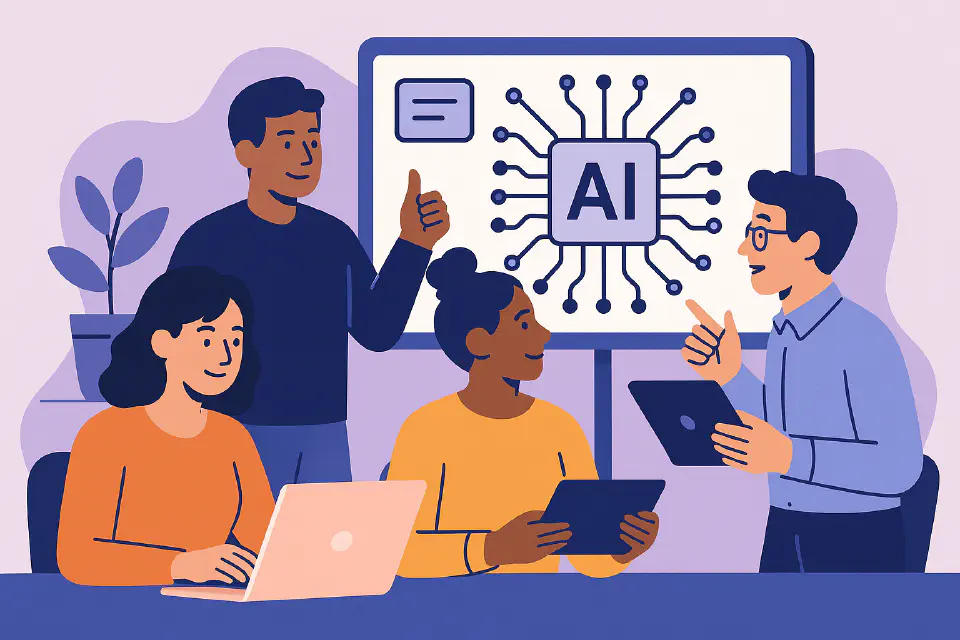
How to Build AI-Ready Teams: A Practical Guide for HR Leaders
Forget the hype—AI fluency is the new must-have skill in nearly every role. Here’s how HR teams can measure and develop it across the business.
The New Core Skill: Why AI Fluency Matters for HR
There was a time when knowing Excel macros made you the most tech-savvy person in HR. Those days are over.
Today, we’re facing a much bigger shift: artificial intelligence is not just automating processes—it’s redefining how work is done. From recruiting and onboarding to workforce planning and talent strategy, AI fluency is quickly becoming a foundational capability. Not just for IT. For everyone.
So how do we as HR leaders measure this fluency? How do we hire for it, develop it, and make it part of our culture?
That’s where Zapier’s AI fluency framework comes in—and trust me, it’s one of the most usable tools out there right now.
A Practical Model for Measuring AI Fluency
Zapier’s CEO Wade Foster recently laid out a simple but powerful model for assessing AI readiness in individuals. Think of it as a 4-level maturity scale:
- Unacceptable – Doesn’t understand or avoids AI, sees it as irrelevant or threatening.
- Capable – Uses basic tools like ChatGPT or Zapier for small tasks or automation.
- Adoptive – Starts embedding AI into workflows, experiments with new applications.
- Transformative – Reimagines work through AI, driving strategic change and innovation.
This isn’t a quiz. It’s a mindset and behavior framework that HR can use in hiring, training, and leadership development.
Integrating AI Fluency Into Hiring
Let’s be honest—most job descriptions still don’t mention AI at all. And if they do, it’s buried in the “nice to have” section. That’s a missed opportunity.
Instead, we should be designing interview questions and assessments that match the role and expected fluency level.
Examples by Role:
- HR Generalist: “Tell me about a time you used AI to improve an HR process. What did it change?”
- Recruiter: “How have you used automation or AI tools in sourcing or candidate engagement?”
- Marketing Manager: “What role did AI play in your last campaign planning or optimization?”
- Product Lead: “Have you integrated AI into product design or user experience? Show us how.”
These aren’t trick questions—they reveal whether a candidate is simply aware, already experimenting, or driving change.
Beyond Hiring: Developing AI Fluency Internally
Hiring for AI fluency is just the beginning. If we want an AI-ready organization, we need to nurture that capability inside the business.
Here’s how HR can drive that:
1. Build Learning Paths Based on Fluency Levels
- Capable → Adoptive: Offer workshops on prompt engineering, automation basics.
- Adoptive → Transformative: Assign AI project ownership, innovation challenges.
2. Incorporate AI Behaviors in Performance Reviews
- Is the employee identifying automation opportunities?
- Are they sharing insights with their team?
- Are managers creating space for experimentation?
3. Use It in Succession Planning
Let’s stop promoting future leaders based on tenure alone. If someone shows Transformative AI behavior, that’s leadership material in a digital-first world.
Creating a Culture That Learns with AI
The real goal isn’t to train everyone into prompt engineers—it’s to foster confidence and curiosity about AI.
That starts with:
- Identifying internal champions who love testing tools and can mentor others.
- Running pilots that allow employees to safely explore AI in real tasks.
- Rewarding experimentation even if it doesn’t always work.
Organizations that embrace this mindset will adapt faster—and attract the kind of talent that thrives on growth.
Final Recommendation
AI is not just another trend on the HR bingo card. It’s changing how we recruit, develop, and lead.
Start where you are: assess current fluency across your team. Add AI awareness into your job descriptions. Use real examples in interviews. Create safe spaces to learn. Recognize those who are already transforming how work gets done.
Because in the future of work, AI fluency will be as fundamental as communication or leadership.
And the companies that win? They’ll be the ones that built AI-ready teams—not just AI-ready tools.